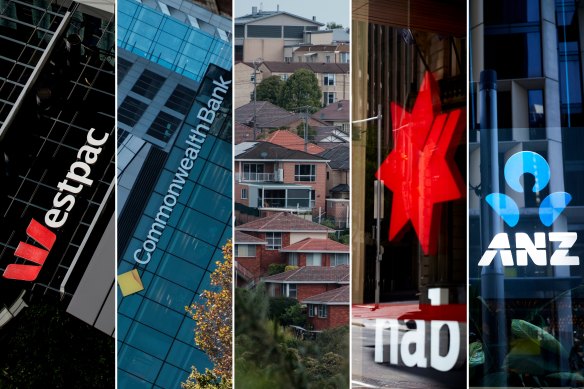This was published 8 months ago
Opinion
Emptying the cookie jar to pay interest: Borrowers are desperate for rates to fall
Elizabeth Knight
Business columnistIt feels like many Australian borrowers are emptying the last few coins from the cookie jar to pay interest as they limp towards the finish line – the first easing of interest rates next year.
There are plenty of white-knuckled borrowers waiting for February in hopes the Reserve Bank will follow most other central banks around the world and begin down the path of lowering rates.
The local bank profit season, which finished on Wednesday when the Commonwealth Bank released its latest quarterly earnings, showed clear evidence that the proportion of borrowers falling behind in paying interest on their loans had continued to creep up.

Most of the big banks have noticed an uptick in loan arrears.
While the CBA said its mortgage delinquencies were largely stable, its three peers saw this metric clearly rising.
The most recent lifeline for borrowers came in the form of the federal government’s stage 3 tax cuts, which the banks acknowledged was providing a bit more juice for stretched borrowers.
Similarly, tax income returns from the 2024 financial year will also have been applied to interest payments, which would have saved some borrowers from falling into the arrears basket over the past couple of months.
Still, the number of borrowers 90 days behind in their mortgage repayments is at a three-year-high, according to ANZ chief executive Shayne Elliott – even though viewed from a historical perspective, the rates of arrears are not especially high.
That said, all the bank chief executives acknowledged that sticky inflation combined with elevated interest rates were placing a strain on many borrowers, including businesses.
National Australia Bank’s new chief executive, Andrew Irvine, said that while hardship applications had plateaued in the second half of the year, he expected arrears to continue rising in 2025.
The recent spike is a clear sign that households’ COVID cash buffers are almost drained, and a cohort of borrowers is desperate for an interest rate reprieve.
Elliott suggested that those still paying on time could probably continue to do so for another six months.
Borrowers have been placing any spare change into mortgage offset accounts to take some of the sting out of higher rates.
The good news is that all the big four banks are expecting the RBA to cut before six months. Indeed, most economists are predicting February as the most likely time for the central bank to hit the button on rates.
That said, in delivering CBA’s flat quarterly profit on Wednesday, chief executive Matt Comyn noted that inflation was moderating at a slower pace. At the same time, the economy continues to be sluggish.
The wild card is what he described as “global geopolitical tensions”. The path of the wars in the Middle East and Ukraine may be altered by Donald Trump’s election to the White House, but how remains to be seen.
Meanwhile, economists and markets around the world are bracing for the possibility of a resurgence in inflation if Trump sticks to his promise to impose a fresh round of tariffs on goods imported into the US.
This may play into the RBA’s decision on when and by how much to move rates in Australia.
And while tax returns and tax cuts have assisted borrowers in paying their interest, this money may have otherwise been spent throughout the economy.
The CBA economics team says the stage 3 cuts increased aggregate income, but this has not been converted into stronger spending.
“Households are choosing not to consume out of the tax cuts but are paying down their debt ahead of schedule,” the nation’s biggest bank noted in an economic update. “Flows into offset and redraw accounts over the year through to August have been rising sharply for CBA customers.”
While the RBA does not appear to be in the mood to cut rates right now, there is a wall of hope that this will change by February. For some of the borrowers, it simply has to.
The Market Recap newsletter is a wrap of the day’s trading. Get it each weekday afternoon.